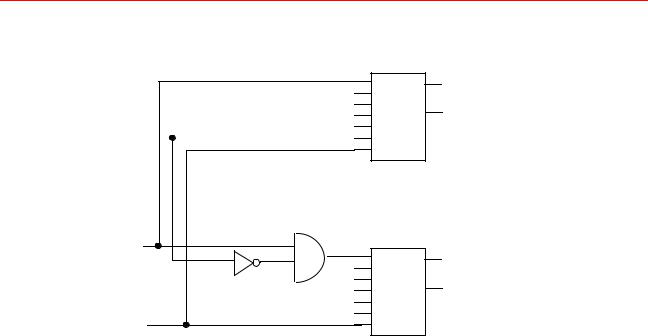
- •Preface
- •About This Manual
- •Other Information Sources
- •Syntax Conventions
- •Text Command Syntax
- •About the Graphical User Interface
- •Using Menus
- •Using Forms
- •HDL Synthesis Overview
- •HDL Synthesis Flow
- •Read Technology Libraries
- •Read Design Data
- •Build Generic Design
- •Save Generic Netlist
- •Synthesizing Mixed VHDL/Verilog Designs
- •Querying the HDL Design Pool
- •Using get_hdl_top_level Command
- •Using get_hdl_hierarchy Command
- •Using get_hdl_type Command
- •Building Generic Netlists from HDL
- •Multiple Top-Level Designs
- •Building Parameterized Designs
- •Verilog Modeling Styles
- •Modeling Combinational Logic
- •Register Inferencing
- •Latch Inference
- •Flip-Flop Inference
- •case Statements
- •Incomplete case Statement
- •Complete case Statement
- •Use of casex and casez Statements
- •for Statement
- •Synthesis Directives
- •Code Selection Directives
- •Architecture Selection Directive
- •case Statement Directives
- •Module Template Directive
- •Function and Task Mapping Directives
- •Set and Reset Synthesis Directives
- •Verilog Preprocessor Directives
- •Compiler Directives
- •The ‘for Compiler Directive
- •The ‘if Compiler Directive
- •The ‘eval Compiler Directive
- •The ‘{} Compiler Directive
- •Command Line Options
- •VPP Flag Attribute
- •Verilog-Related Commands and Globals
- •VHDL Modeling Style
- •Modeling Combinational Logic
- •Register Inferencing
- •Latch Inference
- •Flip-Flop Inferencing
- •Specifying Clock Edges
- •case Statement
- •Incomplete case Statement
- •Complete case Statement
- •for loop
- •Synthesis Directives
- •Code Selection Directives
- •Architecture Selection Directive
- •case Statement Directive
- •Enumeration Encoding Directive
- •Entity Template Directive
- •Function and Procedure Mapping Directives
- •Signed Type Directive
- •Resolution Function Directives
- •Type Conversion Directives
- •Set and Reset Synthesis Directives
- •Reading VHDL Designs
- •Using Arithmetic Packages From Other Vendors
- •Switching between VHDL’87 / VHDL’93
- •Reusing Previously Analyzed Entities
- •Modifying Case of VHDL Names
- •Writing VHDL Netlists
- •Selecting Bit-Level Representation
- •Selecting Between VHDL’87 and VHDL’93
- •Referring to VHDL Packages in Netlists
- •Writing Component Declarations
- •Hierarchical VHDL Designs
- •Component Instantiations and Bindings
- •Restrictions on Entities with Multiple Architectures
- •Precedence Rules for Architecture Selection
- •VHDL-Related Commands and Globals
- •Finite State Machine Overview
- •BuildGates Synthesis and Finite State Machines
- •Extracting the State Transition Table for the FSM
- •Viewing the State Transition Table for the FSM
- •FSM Optimization Features
- •Unreachable State Removal
- •State Assignment or Re-Encoding
- •State Minimization
- •Terminal State Check
- •Verilog and VHDL FSM Directives
- •Verilog FSM Directives
- •VHDL FSM Directives
- •FSM Coding Styles
- •Using the -reachable Option
- •Avoiding a Simulation Mismatch
- •EDIF Interface
- •Reading EDIF Designs
- •Writing EDIF Designs
- •Representing Power and Ground in EDIF
- •Net Representation for Power and Ground
- •Port Representation for Power and Ground
- •Instance Representation for Power and Ground
- •Verilog Constructs
- •Fully Supported Constructs
- •Declarations
- •Operators and Expressions
- •Partially Supported Constructs
- •Ignored Constructs
- •Unsupported Constructs
- •Summary of Verilog Constructs
- •VHDL Constructs
- •Notes on Supported Constructs

Envisia HDL Modeling Reference
VHDL Modeling Style
Figure 3-5 Implementation of set and reset Synchronous Signals in a Block Logic
|
1 |
|
0 |
|
0 |
rst |
0 |
din
1
0
0
0
0
clk
D Q SEN
AS Q_ AR
SS
SR
CLK
D Q SEN
AS Q_ AR
SS
SR
CLK
out1
out2
Reading VHDL Designs
This section describes how to read VHDL designs into BuildGates synthesis.
Defining Logical Libraries
Each logical library used in a design with the exception of the library WORK must be associated with a physical directory, using the set_vhdl_library command.
Defining a New Logical Library
To define a new logical library, use the command as follows:
ac_shell[1]> set_vhdl_library logical_library directory
The directory name must be a valid path to an existing directory. The advantage of creating a library in this manner is that the contents of the library are preserved from one synthesis run to another.
For example:
ac_shell[1]> set_vhdl_library MYLIB /home/me/vhdlibs/lib1
ac_shell[2]> read_vhdl -library MYLIB design.vhd
The above commands analyze the file design.vhd into library MYLIB.
September 2000 |
73 |
Product Version 4.0 |

Envisia HDL Modeling Reference
VHDL Modeling Style
Mapping the WORK Library to an Existing Logical Library
To map the WORK library to an existing logical library, use the command as follows:
ac_shell[1]> set_vhdl_library WORK library
The library name must be the name of an existing logical library. All subsequent read_vhdl commands that do NOT have an explicit -library flag, will result in the files being analyzed and stored into the last library to which WORK was mapped. For example:
ac_shell[1]> set_vhdl_library MYLIB /home/me/vhdlibs/lib1
ac_shell[2]> set_vhdl_library WORK MYLIB
The following commands are identical and will cause design.vhd to be analyzed and stored into library MYLIB:
ac_shell[3]> read_vhdl design.vhd
ac_shell[4]> read_vhdl -library MYLIB design.vhd
However, the following command analyzes and stores information from design.vhd to library ADLIB:
ac_shell[5]> read_vhdl -library ADLIB design.vhd
By default, the library WORK is mapped to the logical library TEMP. An error message is generated if two VHDL libraries are mapped to the same physical directory.
The report_vhdl_library command shows the mapping between VHDL logical libraries and the corresponding physical directory.
An error message is generated if an attempt is made to analyze a VHDL design unit into one of the standard libraries (STD, AMBIT, IEEE, SYNERGY, SYNOPSYS) without mapping the library to a new directory using the set_vhdl_library command.
Predefined VHDL Environment
Below are listed the four predefined VHDL environments which are available in BuildGates synthesis. These environments differ mainly in the choice of the arithmetic packages that can be referred to in VHDL designs.
standard Provides the arithmetic packages standardized by the IEEE. No vendor specific packages are available in this environment. This environment is the default.
synopsys Provides the arithmetic packages supported by Synopsys’ VHDL Compiler.
These packages are not approved nor standardized in IEEE (even though they are compiled into the VHDL library ’IEEE’).
September 2000 |
74 |
Product Version 4.0 |

Envisia HDL Modeling Reference
VHDL Modeling Style
synergy Provides the arithmetic packages supported by Cadence’s Synergy synthesis tool.
common Union of the standard and synopsys environments that can be used in the rare instance that the design refers to arithmetic packages from both these environments.
While the default environment for BuildGates synthesis is standard, the environment setting can be changed by setting the global hdl_vhdl_environment as follows:
set_global hdl_vhdl_environment {standard|synopsys|synergy|common}
Note: The set_global command must be executed before executing read_vhdl or do_build_generic and must not be changed during the design analysis.
Table 3-1 lists the VHDL libraries and packages that are available with the standard (default) environment.
Table 3-1 Predefined VHDL Libraries for the standard Environment
Library |
Packages |
|
|
AMBIT |
attributes |
STD |
standard |
|
textio |
IEEE |
std_logic_1164 |
|
numeric_bit |
|
numeric_std |
|
|
Table 3-2 lists the VHDL libraries and packages that are available with the synopsys environment.
Table 3-2 Predefined VHDL Libraries for the synopsys Environment
Library |
Packages |
|
|
AMBIT |
attributes |
STD |
standard |
|
textio |
September 2000 |
75 |
Product Version 4.0 |

Envisia HDL Modeling Reference
VHDL Modeling Style
Table 3-2 Predefined VHDL Libraries for the synopsys Environment
SYNOPSYS |
attributes |
|
bv_arithmetic |
IEEE |
std_logic_1164 |
|
std_logic_arith |
|
std_logic_misc |
|
std_logic_signed |
|
std_logic_textio |
|
std_logic_unsigned |
|
|
Table 3-3 lists the VHDL libraries and packages that are available with the synergy environment.
Table 3-3 Predefined VHDL Libraries for the synergy Environment
Library |
Packages |
|
|
AMBIT |
attributes |
|
|
STD |
standard |
|
textio |
|
|
SYNERGY |
constraints |
|
signed_arith |
|
std_logic_misc |
|
|
IEEE |
std_logic_1164 |
|
std_logic_arith |
|
std_logic_textio |
|
|
Table 3-4 lists the VHDL libraries and packages that are available with the common environment.
Table 3-4 Predefined VHDL Libraries for the common Environment
Library |
Packages |
|
|
September 2000 |
76 |
Product Version 4.0 |
